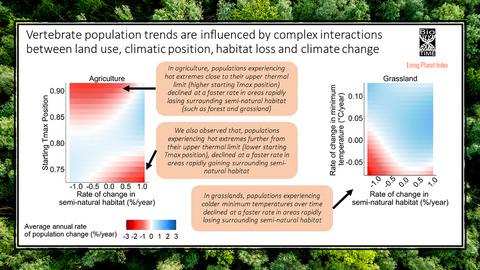当前位置:
X-MOL 学术
›
Glob. Change Biol.
›
论文详情
Our official English website, www.x-mol.net, welcomes your
feedback! (Note: you will need to create a separate account there.)
Vertebrate population trends are influenced by interactions between land use, climatic position, habitat loss and climate change
Global Change Biology ( IF 10.8 ) Pub Date : 2021-11-26 , DOI: 10.1111/gcb.15978 Jessica J Williams 1 , Robin Freeman 2 , Fiona Spooner 3 , Tim Newbold 1
Global Change Biology ( IF 10.8 ) Pub Date : 2021-11-26 , DOI: 10.1111/gcb.15978 Jessica J Williams 1 , Robin Freeman 2 , Fiona Spooner 3 , Tim Newbold 1
Affiliation

|
Rapid human-driven environmental changes are impacting animal populations around the world. Currently, land-use and climate change are two of the biggest pressures facing biodiversity. However, studies investigating the impacts of these pressures on population trends often do not consider potential interactions between climate and land-use change. Further, a population's climatic position (how close the ambient temperature and precipitation conditions are to the species’ climatic tolerance limits) is known to influence responses to climate change but has yet to be investigated with regard to its influence on land-use change responses over time. Consequently, important variations across species’ ranges in responses to environmental changes may be being overlooked. Here, we combine data from the Living Planet and BioTIME databases to carry out a global analysis exploring the impacts of land use, habitat loss, climatic position, climate change and the interactions between these variables, on vertebrate population trends. By bringing these datasets together, we analyse over 7,000 populations across 42 countries. We find that land-use change is interacting with climate change and a population's climatic position to influence rates of population change. Moreover, features of a population's local landscape (such as surrounding land cover) play important roles in these interactions. For example, populations in agricultural land uses where maximum temperatures were closer to their hot thermal limit, declined at faster rates when there had also been rapid losses in surrounding semi-natural habitat. The complex interactions between these variables on populations highlight the importance of taking intraspecific variation and interactions between local and global pressures into account. Understanding how drivers of change are interacting and impacting populations, and how this varies spatially, is critical if we are to identify populations at risk, predict species’ responses to future environmental changes and produce suitable conservation strategies.
中文翻译:

脊椎动物种群趋势受到土地利用、气候位置、栖息地丧失和气候变化之间相互作用的影响
人类驱动的快速环境变化正在影响世界各地的动物种群。目前,土地利用和气候变化是生物多样性面临的两大压力。然而,调查这些压力对人口趋势的影响的研究通常没有考虑气候和土地利用变化之间的潜在相互作用。此外,已知种群的气候位置(环境温度和降水条件与物种的气候耐受极限的接近程度)会影响对气候变化的响应,但尚未就其对土地利用变化响应的影响进行调查。时间。因此,物种对环境变化的反应范围内的重要变化可能会被忽视。这里,我们结合来自 Living Planet 和 BioTIME 数据库的数据进行全球分析,探索土地利用、栖息地丧失、气候位置、气候变化以及这些变量之间的相互作用对脊椎动物种群趋势的影响。通过将这些数据集整合在一起,我们分析了 42 个国家的 7,000 多个人口。我们发现土地利用变化与气候变化和人口的气候位置相互作用,从而影响人口变化的速度。此外,人口的当地景观特征(例如周围的土地覆盖)在这些相互作用中起着重要作用。例如,在最高温度接近其高温极限的农业用地用途中,当周围的半自然栖息地也迅速丧失时,人口以更快的速度下降。这些变量之间对种群的复杂相互作用突出了考虑种内变异以及局部和全球压力之间相互作用的重要性。如果我们要识别处于危险中的种群、预测物种对未来环境变化的反应并制定合适的保护策略,了解变化的驱动因素如何相互作用和影响种群,以及这种变化如何在空间上变化是至关重要的。
更新日期:2022-01-05
中文翻译:

脊椎动物种群趋势受到土地利用、气候位置、栖息地丧失和气候变化之间相互作用的影响
人类驱动的快速环境变化正在影响世界各地的动物种群。目前,土地利用和气候变化是生物多样性面临的两大压力。然而,调查这些压力对人口趋势的影响的研究通常没有考虑气候和土地利用变化之间的潜在相互作用。此外,已知种群的气候位置(环境温度和降水条件与物种的气候耐受极限的接近程度)会影响对气候变化的响应,但尚未就其对土地利用变化响应的影响进行调查。时间。因此,物种对环境变化的反应范围内的重要变化可能会被忽视。这里,我们结合来自 Living Planet 和 BioTIME 数据库的数据进行全球分析,探索土地利用、栖息地丧失、气候位置、气候变化以及这些变量之间的相互作用对脊椎动物种群趋势的影响。通过将这些数据集整合在一起,我们分析了 42 个国家的 7,000 多个人口。我们发现土地利用变化与气候变化和人口的气候位置相互作用,从而影响人口变化的速度。此外,人口的当地景观特征(例如周围的土地覆盖)在这些相互作用中起着重要作用。例如,在最高温度接近其高温极限的农业用地用途中,当周围的半自然栖息地也迅速丧失时,人口以更快的速度下降。这些变量之间对种群的复杂相互作用突出了考虑种内变异以及局部和全球压力之间相互作用的重要性。如果我们要识别处于危险中的种群、预测物种对未来环境变化的反应并制定合适的保护策略,了解变化的驱动因素如何相互作用和影响种群,以及这种变化如何在空间上变化是至关重要的。











































 京公网安备 11010802027423号
京公网安备 11010802027423号